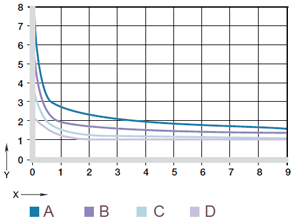iglidur® - p x v value and lubrication
| Material | Heat coefficient [W/m x k] |
| Steel | 46 |
| Aluminum | 204 |
| Cast iron | 58 |
| V2A | 16 |
| Ceramic | 1,4 |
| Plastic | 0,24 |

X = duty cycle[min]
Y = Correction factor
A = 4-times
B = 3-times
C = 2-times
D = 1-times
Figure 09: Correction factor of the permissible pv value by intermittent service

Picture 04: Testing of the properties of polymer bearings
| Lubrication | Correction factor |
| Dry operation | 1 |
| In the installation | 1,3 |
| Persistent, fat | 2 |
| Persistent, water | 4 |
| Persistent, oil | 5 |
The product gains special importance for bearings from the specific load [p] and the surface speed [v]. The p x v value can be seen as a measurement of frictional heat and can therefore be used as an analytical medium to justify the applicability of a bearing. For this purpose the actual p x v value is compared with a permitted p x v value calculable for the height. The permitted p x v value is dependent on the material of the glide partner, ambient temperature and the on-time.

Present is
| K1, K2 | Constant for heat conductivity |
| (K1 = 0,5, K2 = 0,042) | |
| s | Bearing wall thickness in mm |
| b1 | Bearing length in mm |
| μ | Coefficient of friction |
| λs | Heat conductivity of the shaft |
| λk | Heat conductivity of the bearing |
| ΔT | (Ta - T u) |
| Tu | Ambient temperature |
| Ta | Max. ambient temperature |
The permitted p x v value can be raised in the intermittent service, if the bearing temperature has not at all reached the maximum due to the short turn-on times. Tests have shown that this is the case in turn-on times under 10 minutes. The shorter the turn-on time, naturally lower is the highest bearing temperature attained.
An important factor is thereby the ratio of on-time and breaks. It is clear that long breaks strongly contribute to the cooling down. The different curves in Fig. 09 stand for the different ratios ("3 times" means the break is 3 times longer than the on-time).
Though the iglidur® bearings are designed for dry operation, they tolerate common oils and fats very well. A one-time lubrication at installation enhances the running behavior and the coefficient of friction and thereby reduces the generated frictional heat. By this effect, a lubrication increases the permitted loads of bearings. There are numerous results available from tests with lubricated applications. Please contact us for the results. Table 03 shows the correction factor for the p x v value in the use of lubricants.
More than 100,000 products available! Delivery and consultation Mon-Fri from 7am-8pm and Sat from 8am-12pm!